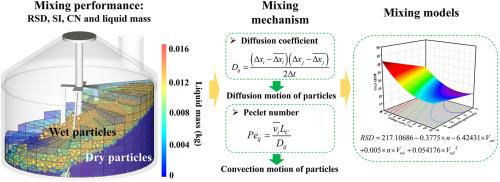Mixing performance for wet and sticky bulk materials in a vertical blender using DEM simulation
IF 4.3
2区 材料科学
Q2 ENGINEERING, CHEMICAL
引用次数: 0
Abstract
Wet and sticky bulk materials exhibit poor flowability during the mixing process, which prevents adequate contact between dry and wet particles. This results in uneven moisture distribution and deterioration in the mixing system. To address these issues, the mixing process of viscous concrete was focused on a vertical blender. A comprehensive investigation into mixing mechanisms and particles flow patterns were conducted using the discrete element method (DEM). The accuracy of the contact parameters in DEM was calibrated through repose angle and validated by torques tested in a custom-built mixing platform. And then, the effects of moisture content, filling level, rotational speed, and inclined angle were systematically investigated with respect to key mixing metrics: the relative standard deviation (RSD), coordination number (CN), segregation index (SI) of wet particles, as well as liquid mass. The results indicated that when the moisture content is 8 %, filling level is 50 %, and rotational speed is more than 60 rpm, the CN and mixing efficiency are acceptable, and the RSD and SI are low, thereby improving the mixing quality. The convective motion was revealed as the dominant flow regime through statistical quantification of diffusion coefficients and Peclet numbers. Finally, Box-Behnken Design was employed to develop quadratic polynomial models for RSD, CN, and SI, which demonstrated strong accuracy in predicting mixing performance and enabled systematic optimization of critical process parameters.

基于DEM模拟的湿性和粘性散装物料在立式搅拌器中的混合性能
在混合过程中,湿的和粘性的大块材料表现出较差的流动性,这阻碍了干湿颗粒之间的充分接触。这将导致混合系统中的水分分布不均匀和劣化。为了解决这些问题,粘性混凝土的搅拌过程集中在一个垂直搅拌机上。采用离散元法(DEM)对混合机制和颗粒流动模式进行了全面的研究。通过休养角对DEM中接触参数的精度进行了标定,并在定制的混合平台上进行了扭矩测试。然后,系统考察了含水率、填充水平、转速和倾斜角度对湿颗粒相对标准偏差(RSD)、配位数(CN)、偏析指数(SI)和液体质量等关键混合指标的影响。结果表明,当水分含量为8%,填充量为50%,转速大于60 rpm时,CN和混合效率可接受,RSD和SI较低,从而提高了混合质量。通过对扩散系数和佩莱特数的统计量化,揭示了对流运动是主要的流动形式。最后,利用Box-Behnken Design建立了RSD、CN和SI的二次多项式模型,该模型在预测混合性能方面具有很强的准确性,并能够对关键工艺参数进行系统优化。
本文章由计算机程序翻译,如有差异,请以英文原文为准。
求助全文
约1分钟内获得全文
求助全文
来源期刊

Particuology
工程技术-材料科学:综合
CiteScore
6.70
自引率
2.90%
发文量
1730
审稿时长
32 days
期刊介绍:
The word ‘particuology’ was coined to parallel the discipline for the science and technology of particles.
Particuology is an interdisciplinary journal that publishes frontier research articles and critical reviews on the discovery, formulation and engineering of particulate materials, processes and systems. It especially welcomes contributions utilising advanced theoretical, modelling and measurement methods to enable the discovery and creation of new particulate materials, and the manufacturing of functional particulate-based products, such as sensors.
Papers are handled by Thematic Editors who oversee contributions from specific subject fields. These fields are classified into: Particle Synthesis and Modification; Particle Characterization and Measurement; Granular Systems and Bulk Solids Technology; Fluidization and Particle-Fluid Systems; Aerosols; and Applications of Particle Technology.
Key topics concerning the creation and processing of particulates include:
-Modelling and simulation of particle formation, collective behaviour of particles and systems for particle production over a broad spectrum of length scales
-Mining of experimental data for particle synthesis and surface properties to facilitate the creation of new materials and processes
-Particle design and preparation including controlled response and sensing functionalities in formation, delivery systems and biological systems, etc.
-Experimental and computational methods for visualization and analysis of particulate system.
These topics are broadly relevant to the production of materials, pharmaceuticals and food, and to the conversion of energy resources to fuels and protection of the environment.
 求助内容:
求助内容: 应助结果提醒方式:
应助结果提醒方式:


